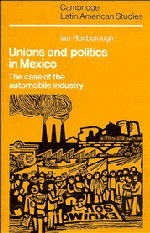Book contents
- Frontmatter
- Contents
- List of tables
- List of figures
- Acknowledgements
- Dedication
- Preface
- List of abbreviations
- Map: Location of automobile plants
- 1 Organized labour in Mexico
- 2 The Mexican automobile industry
- 3 Wages and workers in the Mexican automobile industry
- 4 The unions: a historical analysis
- 5 The unions: power and organization
- 6 Control over work processes
- 7 Union government
- 8 The labour courts
- 9 The empirical findings and the dynamics of industrial militancy
- 10 Unions and political stability in Mexico
- Notes
- Bibliography
- Index
- CAMBRIDGE LATIN AMERICAN STUDIES
4 - The unions: a historical analysis
Published online by Cambridge University Press: 04 August 2010
- Frontmatter
- Contents
- List of tables
- List of figures
- Acknowledgements
- Dedication
- Preface
- List of abbreviations
- Map: Location of automobile plants
- 1 Organized labour in Mexico
- 2 The Mexican automobile industry
- 3 Wages and workers in the Mexican automobile industry
- 4 The unions: a historical analysis
- 5 The unions: power and organization
- 6 Control over work processes
- 7 Union government
- 8 The labour courts
- 9 The empirical findings and the dynamics of industrial militancy
- 10 Unions and political stability in Mexico
- Notes
- Bibliography
- Index
- CAMBRIDGE LATIN AMERICAN STUDIES
Summary
This chapter provides a historical account of the development of the unions in the Mexican automobile industry. Each union is treated separately, and systematic comparisons among them are postponed until chapters 5–8.
As indicated in chapter 1, Mexican labour law allows for the formation of a variety of types of union: plant unions, enterprise unions, national industrial unions, craft unions and general unions. There is, therefore, no reason in principle why the Mexican automobile industry should not have been organized into a single national industrial union, like the United Auto Workers of America or, indeed, into a series of craft unions and general unions, as in the United Kingdom. The automobile industry could, also, have been incorporated into the large mining–metallurgical union. As it happened, the automobile industry in Mexico was basically organized on a plant-by-plant or enterprise-by-enterprise level.
The situation in 1978 is outlined in table 2.1. With the exception of the GM plant in Toluca, where the union was organized as a section of a state-wide metallurgical union (and the Ford plants prior to 1977, which were organized in a similar manner), all the unions in the industry were autonomous entities, affiliated to various union confederations but in principle enjoying autonomy in bargaining and union government.
The organization of this chapter follows the chronological establishment of the automobile plants in Mexico. The oldest firms are discussed first.
- Type
- Chapter
- Information
- Unions and Politics in MexicoThe Case of the Automobile Industry, pp. 75 - 108Publisher: Cambridge University PressPrint publication year: 1984



